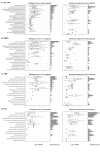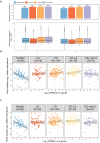Microbial genetic and transcriptional contributions to oxalate degradation by the gut microbiota in health and disease
- PMID: 33769280
- PMCID: PMC8062136
- DOI: 10.7554/eLife.63642
Microbial genetic and transcriptional contributions to oxalate degradation by the gut microbiota in health and disease
Abstract
Over-accumulation of oxalate in humans may lead to nephrolithiasis and nephrocalcinosis. Humans lack endogenous oxalate degradation pathways (ODP), but intestinal microbes can degrade oxalate using multiple ODPs and protect against its absorption. The exact oxalate-degrading taxa in the human microbiota and their ODP have not been described. We leverage multi-omics data (>3000 samples from >1000 subjects) to show that the human microbiota primarily uses the type II ODP, rather than type I. Furthermore, among the diverse ODP-encoding microbes, an oxalate autotroph, Oxalobacter formigenes, dominates this function transcriptionally. Patients with inflammatory bowel disease (IBD) frequently suffer from disrupted oxalate homeostasis and calcium oxalate nephrolithiasis. We show that the enteric oxalate level is elevated in IBD patients, with highest levels in Crohn's disease (CD) patients with both ileal and colonic involvement consistent with known nephrolithiasis risk. We show that the microbiota ODP expression is reduced in IBD patients, which may contribute to the disrupted oxalate homeostasis. The specific changes in ODP expression by several important taxa suggest that they play distinct roles in IBD-induced nephrolithiasis risk. Lastly, we colonize mice that are maintained in the gnotobiotic facility with O. formigenes, using either a laboratory isolate or an isolate we cultured from human stools, and observed a significant reduction in host fecal and urine oxalate levels, supporting our in silico prediction of the importance of the microbiome, particularly O. formigenes in host oxalate homeostasis.
Keywords: IBD; computational biology; gene expressions; human; infectious disease; metagenome; metatranscriptome; microbiology; microbiota; mouse; oxalate metabolism; systems biology.
© 2021, Liu et al.
Conflict of interest statement
ML, JD, JH, AV, TB, MH, PL, HL, KR, AT, MB, LN No competing interests declared, JA is an employee of Litholink, AB is an employee of Genentech
Figures

























Similar articles
-
Forty Years of Oxalobacter formigenes, a Gutsy Oxalate-Degrading Specialist.Appl Environ Microbiol. 2021 Aug 26;87(18):e0054421. doi: 10.1128/AEM.00544-21. Epub 2021 Aug 26. Appl Environ Microbiol. 2021. PMID: 34190610 Free PMC article. Review.
-
Oxalobacter formigenes-associated host features and microbial community structures examined using the American Gut Project.Microbiome. 2017 Aug 25;5(1):108. doi: 10.1186/s40168-017-0316-0. Microbiome. 2017. PMID: 28841836 Free PMC article.
-
Inhibition of urinary stone disease by a multi-species bacterial network ensures healthy oxalate homeostasis.Kidney Int. 2019 Jul;96(1):180-188. doi: 10.1016/j.kint.2019.02.012. Epub 2019 Feb 28. Kidney Int. 2019. PMID: 31130222 Free PMC article.
-
Oxalobacter formigenes and its role in oxalate metabolism in the human gut.FEMS Microbiol Lett. 2004 Jan 15;230(1):1-7. doi: 10.1016/S0378-1097(03)00864-4. FEMS Microbiol Lett. 2004. PMID: 14734158 Review.
-
Enteric hyperoxaluria: role of microbiota and antibiotics.Curr Opin Nephrol Hypertens. 2019 Jul;28(4):352-359. doi: 10.1097/MNH.0000000000000518. Curr Opin Nephrol Hypertens. 2019. PMID: 31145706 Review.
Cited by
-
Complex system modelling reveals oxalate homeostasis is driven by diverse oxalate-degrading bacteria.bioRxiv [Preprint]. 2025 Feb 19:2024.10.28.620613. doi: 10.1101/2024.10.28.620613. bioRxiv. 2025. Update in: Elife. 2025 May 01;14:RP104121. doi: 10.7554/eLife.104121. PMID: 39553961 Free PMC article. Updated. Preprint.
-
An engineered bacterial therapeutic lowers urinary oxalate in preclinical models and in silico simulations of enteric hyperoxaluria.Mol Syst Biol. 2022 Mar;18(3):e10539. doi: 10.15252/msb.202110539. Mol Syst Biol. 2022. PMID: 35253995 Free PMC article.
-
A membrane protein of the rice pathogen Burkholderia glumae required for oxalic acid secretion and quorum sensing.Mol Plant Pathol. 2023 Nov;24(11):1400-1413. doi: 10.1111/mpp.13376. Epub 2023 Jul 10. Mol Plant Pathol. 2023. PMID: 37428013 Free PMC article.
-
Postbiotics and Kidney Disease.Toxins (Basel). 2022 Sep 6;14(9):623. doi: 10.3390/toxins14090623. Toxins (Basel). 2022. PMID: 36136562 Free PMC article. Review.
-
Novel microbiota-related gene set enrichment analysis identified osteoporosis associated gut microbiota from autoimmune diseases.J Bone Miner Metab. 2021 Nov;39(6):984-996. doi: 10.1007/s00774-021-01247-w. Epub 2021 Aug 2. J Bone Miner Metab. 2021. PMID: 34338852
References
Publication types
MeSH terms
Substances
Associated data
- Actions
Grants and funding
LinkOut - more resources
Full Text Sources
Other Literature Sources

